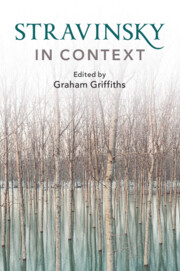Book contents
- Stravinsky in Context
- Composers in Context
- Stravinsky in Context
- Copyright page
- Contents
- Illustrations
- Contributors
- Preface
- Abbreviations
- Frontispiece
- Epigraph
- Part I Russia and Identity
- Part II Stravinsky and Europe
- Part III Partnerships and Authorship
- Part IV Performance and Performers
- Part V Aesthetics and Politics
- Part VI Reception and Legacy
- Chapter 29 The Apollonian Clockwork Rewound
- Chapter 30 Stravinsky Reception in the USSR
- Chapter 31 The Stravinsky/Craft Conversations in Russian and Their Reception
- Chapter 32 Publishing Stravinsky
- Chapter 33 Copyright, the Stravinsky Estate and the Paul Sacher Foundation
- Chapter 34 Evoking the Past, Inspiring the Future
- Chapter 35 ‘Music is, by its very nature, essentially powerless to express anything at all’
- Recommendations for Further Reading and Research
- Index
- Endmatter
Chapter 32 - Publishing Stravinsky
from Part VI - Reception and Legacy
Published online by Cambridge University Press: 03 December 2020
- Stravinsky in Context
- Composers in Context
- Stravinsky in Context
- Copyright page
- Contents
- Illustrations
- Contributors
- Preface
- Abbreviations
- Frontispiece
- Epigraph
- Part I Russia and Identity
- Part II Stravinsky and Europe
- Part III Partnerships and Authorship
- Part IV Performance and Performers
- Part V Aesthetics and Politics
- Part VI Reception and Legacy
- Chapter 29 The Apollonian Clockwork Rewound
- Chapter 30 Stravinsky Reception in the USSR
- Chapter 31 The Stravinsky/Craft Conversations in Russian and Their Reception
- Chapter 32 Publishing Stravinsky
- Chapter 33 Copyright, the Stravinsky Estate and the Paul Sacher Foundation
- Chapter 34 Evoking the Past, Inspiring the Future
- Chapter 35 ‘Music is, by its very nature, essentially powerless to express anything at all’
- Recommendations for Further Reading and Research
- Index
- Endmatter
Summary
The story of Stravinsky’s relationships with music publishers is bound up with the political upheavals of the Russian Revolution and two world wars, as well as the copyright laws of countries in which Stravinsky lived and in which his works were published. In the course of his career, his works were published by a bewildering array of firms including M.P. Belaieff, P. Jurgenson, Édition Russe de musique, Adolphe Henn, J. & W. Chester, Éditions de la Sirène, B. Schotts Söhne, Associated Music Publishers, Leeds Music, Mercury Music Corporation, Charling Music, Edward B. Marks, Edwin Kalmus and Boosey & Hawkes. Stravinsky’s Le Faune et la Bergère (1906) was published by the Russian firm of Belaieff which had an office in Leipzig, its aim being to secure Western European copyrights for Russian composers (notably Rimsky-Korsakov, Stravinsky’s teacher). Although Fireworks was issued by the German firm of Schott in November 1909, most of the other works from Stravinsky’s early years up to and including The Firebird (1910) were issued by P. Jurgenson in Moscow. Founded in 1861, by 1900 it was much the largest music publisher in Russia and remained in the hands of the family until the firm was expropriated on Lenin’s orders in 1918, its catalogue forming the basis of the nationalised State Music Publishing House.
- Type
- Chapter
- Information
- Stravinsky in Context , pp. 288 - 295Publisher: Cambridge University PressPrint publication year: 2020



